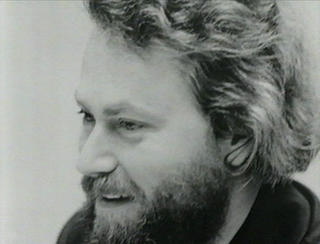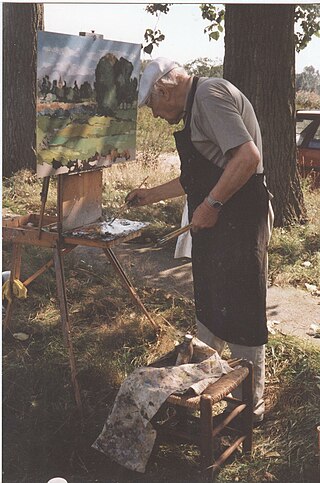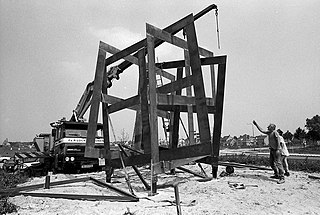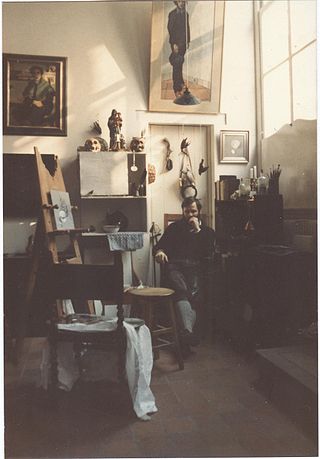Related Research Articles
Paul Panhuysen was a Dutch composer, visual and sound artist. He founded and directed Het Apollohuis, an art space that functioned during the 80's and 90's having artists doing sound installations, sound sculptures, and concerts about free improvisation, experimental music, and electronic music.

Donald Clarence Judd was an American artist associated with minimalism. In his work, Judd sought autonomy and clarity for the constructed object and the space created by it, ultimately achieving a rigorously democratic presentation without compositional hierarchy. He is generally considered the leading international exponent of "minimalism", and its most important theoretician through such writings as "Specific Objects" (1964). Judd voiced his unorthodox perception of minimalism in Arts Yearbook 8, where he says, "The new three dimensional work doesn't constitute a movement, school, or style. The common aspects are too general and too little common to define a movement. The differences are greater than the similarities."

Chrispijn van den Broeck was a Flemish painter, draughtsman, print designer and designer of temporary decorations. He was a scion of a family of artists, which had its origins in Mechelen and later moved to Antwerp. He is known for his religious compositions and portraits as well as his extensive output of designs for prints. He was active in Antwerp which he left for some time because of the prosecution of persons adhering to his religious convictions.

Cornelis "Kees" Bol was a Dutch painter and art educator. His work was exhibited in art galleries and museums throughout the Netherlands, as well as in Paris. In 1950 Bol was awarded the Thérèse van Duyl-Schwartze Prize and in 1982 he was made Knight in the Order of the Netherlands Lion.
Willy Schmidhamer is a Dutch photographer.
Herman van den Boom is a Belgian photographer, artist, and designer.
Ad Snijders was born in Eindhoven in 1929. He was a painter, a collagist and a social activist.

Pieter Stoop is a Dutch painter of large abstract paintings.
Pieter Celie is a Dutch artist

Jan Goossen was a Dutch sculptor.

Johan Lennarts (1932–1991-10-06) was a Dutch artist.
Lukas Smits is a Dutch painter.
Van den Broeck or Vandenbroeck is a Dutch toponymic surname most common in the Belgian provinces of Antwerp and East Flanders. "Broeck" is an archaic spelling of "broek" meaning "swamp". Notable people with the surname include:

St. Joost School of Art and Design is a Dutch academy of art and design based in Breda and 's-Hertogenbosch. The school is part of Avans University of Applied Sciences with offices in Breda, 's-Hertogenbosch and Tilburg.

Henri Cornelis Bol was a Dutch still life painter, whose work was noted for its realism and trompe-l'œil technique.

Jan Hillebrand Wijsmuller was a Dutch painter. He belongs to The 2. Golden Age of Dutch Painting.

Henricus Petrus Cornelis (Kees) Verschuren is a Dutch sculptor, painter and former lecturer at the Willem de Kooning Academie in Rotterdam, known for his monumentalist sculptures in public places in the Netherlands.
Teunis (Teun) Jacob was a Dutch wall painter and sculptor, who lived and worked in Rotterdam since the early 1950s. He made both figure and nonrepresentational art.

Jaap Schreurs was a Dutch painter and graphic artist in the neo-figurative style.

Willem van den Broecke, Willem van den Broeck or Guillelmus Paludanus was a Flemish sculptor, painter, draughtsman and architect. He was a scion of a family of artists, which had its origins in Mechelen and some members of which later moved to Antwerp. Willem was active in Antwerp and also worked and likely trained in Italy for a long period. He was known for his small scale works, many of which were executed in alabaster. He was, along with Cornelis Floris, the leading sculptor in Antwerp in the second half of the 16th century. He was also one of the designers of the Antwerp City Hall. He enjoyed the patronage of an elite international clientele of church institutions, Spanish nobility, princes of Protestant territories as well as patricians from Augsburg.
References
- ↑ Scheen, Pieter A. Lexicon Nederlandse beeldende kunstenaars, 1750–1950, 's-Gravenhage: Scheen, 1969 [2-delig]: p. 164 (als: Broeck, Clemens Hugo Franciscus Maria ('Clemens') van den;*); Jacobs, P.M.J. Beeldend Nederland: biografisch handboek {2}, Tilburg: P.M.J. Jacobs, 1993, p. 182. From now on all the biographical references comes from these two sources.
- ↑ H. J. Verwiel, "Kreaties zonder status van Clemens van den Broeck", in Losa, 24 June 1973, pp. 52–4
- ↑ "Galerie Flora vanaf vandaag Flora Design" in Eindhovens Dagblad, 25 June 1983